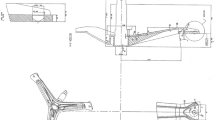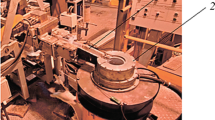Abstract
Automobile steering knuckle is an important part of the steering system, which is subjected to significant impacts and loads during its operation. Generally, cast aluminum steering knuckles are usually produced using some type of enhanced low-pressure casting process, like counter-pressure casting. Compared with aluminum forging and sand cast ductile iron, it can improve the production speed and achieve the adequate casting quality. In this study, various methodologies such as dynamic thermomechanical analysis, differential scanning calorimetry, and the laser flash method were employed to study the thermophysical properties of AlSi7Mg0.3. Further, the physical model of a counter-pressure casting system with an aluminum interior was established based on the combination of the tested and the theoretical properties of aluminum; this was achieved with the consideration of the presence of other factors including rapid solidification. The temperature field of the system was computed and verified by thermocouples at six different points during the tooling and the shrinkage simulation. It was observed that the plot shape of the computed temperatures and that of the simulated ones correlated; further, the difference between the peaks and the valleys was controlled to be 3% on an average, with the maximum variation of 7% at only one point. Moreover, all the predicted shrinkages were verified by the casting. This study provides a solid foundation for facilitating the simulation of the morphologies of the microstructure.















Similar content being viewed by others
References
A. Biswas, D.J. Siegel, D.N. Seidman, Compositional evolution of Q-phase precipitates in an aluminum alloy. Acta Mater. 75(9), 322–336 (2014)
J.L. Murray, A.J. Mcalister, The Al–Si (aluminum–silicon) system. Bull. Alloy Phase Diagr. 5(1), 74 (1984)
F. Hsu, P. Chen, H. Lin, C. Wu, Boiling phenomena of cooling water in the permanent mold. Int. J. Metalcasting 9(2), 31–40 (2015)
D. Sui, Z. Cui, R. Wang, S. Hao, Q. Han, Effect of cooling process on porosity in the aluminum alloy automotive wheel during low-pressure die casting. Int. J. Metalcasting 10(1), 32–42 (2016)
Q.S. Yan, H. Yu, Z.F. Xu, B.W. Xiong, C.C. Cai, Effect of holding pressure on the microstructure of vacuum counter-pressure casting aluminum alloy. J. Alloy. Compd. 501(2), 352–357 (2010)
J. Jorstad, D. Apelian, Pressure assisted processes for high integrity aluminum castings. Int. J. Metalcasting 2(1), 19–39 (2008)
L.M. Galantucci, L. Tricarico, A computer aided approach for the simulation of the directional solidification process for gas turbine blades. J. Mater. Process. Technol. 77(1–3), 160–165 (1998)
G. Ruff, T.E. Prucha, J. Barry, D. Patterson, Pressure counter pressure casting (PCPC) for automotive aluminum structural components. SAE Trans. 110, 360–365 (2001)
L. Archer, R.A. Hardin, C. Beckermann, Counter-gravity sand casting of steel with pressurization during solidification. Int. J. Metalcasting 12(3), 596–606 (2018)
D. Moore, K. Mohler, X. Wan, Mandating IHTC through casting simulation. Modern Casting 95(8), 30–33 (2005)
P.W. Cleary, J. Ha, V. Ahuja, High pressure die casting simulation using smoothed particle hydrodynamics. Cast Metals 12(6), 335–355 (2000)
H. Shen, R.A. Hardin, R. Mackenzie, C. Beckermann, Simulation using realistic spray cooling for the continuous casting of multi-component steel. J. Mater. Sci. Technol. 18(4), 311–314 (2002)
W. Tu, X. Zhang, H. Shen, B. Liu, Numerical simulation on multiple pouring process for a 292 t steel ingot. China Foundry 11(1), 52–58 (2014)
B. Wang, J.Y. Zhang, X.M. Li, W.H. Qi, Simulation of solidification microstructure in twin-roll casting strip. Comput. Mater. Sci. 49(1), S135–S139 (2010)
E. Anglada, A. Meléndez, L. Maestro, I. Domiguez, Adjustment of numerical simulation model to the investment casting process. Proc. Eng. 63(1784), 75–83 (2013)
Z. Li, Q. Xu, B. Liu, Microstructure simulation on recrystallization of an as-cast nickel based single crystal superalloy. Comput. Mater. Sci. 107, 122–133 (2015)
Z. Li, Q. Xu, B. Liu, Simulation and experimental study of recrystallization kinetics of nickel based single crystal superalloys. Mater. Today Proc. 2(2), S440–S452 (2015)
Y. Du, K. Li, P. Zhao, M. Yang, K. Cheng, M. Wei et al., Integrated computational materials engineering (ICME) for developing aluminum alloys. J. Aeronaut. Mater. 37(1), 1–17 (2017)
M. Jolly, Casting simulation: how well do reality and virtual casting match? State of the art review. Cast Metals 14(5), 303–313 (2002)
H.J. Kwon, H.K. Kwon, Computer aided engineering (CAE) simulation for the design optimization of gate system on high pressure die casting (HPDC) process. Robot. Comput. Integr. Manuf. 55, 147–153 (2019)
R. Kopp, F.D. Philipp, Physical parameters and boundary conditions for the numerical simulation of hot forming processes. Steel Res. Int. 63(9), 392–398 (1992)
P.I. Manilal, D.P.K. Singh, Z.W. Chen, Computer modeling and experimentation for thermal control of dies in permanent mold casting. Trans. Am. Foundry Soc. 111, 125–135 (2003)
T. Vossel, N. Wolff, B. Pustal, A. Bhrig-Polaczek, Influence of die temperature control on solidification and the casting process. Int. J. Metalcasting (2019). https://doi.org/10.1007/s40962-019-00391-4
C. Ying, X. Tang, K. Zhao, H. Ping, Y. Wu, Investigation of the factors influencing the interfacial heat transfer coefficient in hot stamping. J. Mater. Process. Technol. 228, 25–33 (2016)
Funding
Funding was provided by 上海市“创新行动计划”基础研究项目 (Grant Nos. 17JC1400600, 17JC1400603) and 中国国家工信部绿色再制造项目 (Grant No. 先进涡轮发动机热端部件绿色关键工艺系统集成).
Author information
Authors and Affiliations
Corresponding author
Additional information
Publisher's Note
Springer Nature remains neutral with regard to jurisdictional claims in published maps and institutional affiliations.
Rights and permissions
About this article
Cite this article
Tian, Y., Yang, D., Jiang, M. et al. Accurate Simulation of Complex Temperature Field in Counter-Pressure Casting Process Using A356 Aluminum Alloy. Inter Metalcast 15, 259–270 (2021). https://doi.org/10.1007/s40962-020-00456-9
Published:
Issue Date:
DOI: https://doi.org/10.1007/s40962-020-00456-9




